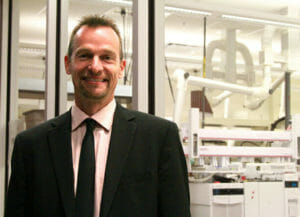
Of the many contemporary conveniences often taken for granted in developed countries, modern sanitation may be among the most important. A new study suggests that wastewater infrastructure may provide societal benefits far beyond the dramatic improvements in community hygiene.
The research highlights a technique known as Wastewater-based Epidemiology (WBE), in which samples of municipal wastewater can be used as a diagnostic tool to explore a surprisingly broad range of community-wide health indices.
In research published in the peer-reviewed, high-impact journal Environment International, Rolf Halden and Sangeet Adhikari, describe how WBE can be used to help achieve a number of ambitious objectives outlined in the United Nations Sustainable Development Goals.
The study, the largest and most comprehensive assessment of wastewater infrastructure around the world to date, examines wastewater treatment facilities in 129 countries, serving over a third of the world’s population. It is also the first study to propose and evaluate the feasibility of using WBE to measure progress toward achieving several UN sustainability objectives.
The WBE technique can be used to assess factors influencing community-wide health, from the consumption of local diets, alcohol, illicit drugs and tobacco to exposure to hazardous chemicals, pharmaceuticals, personal care products, viruses, and antibiotic-resistant microbes.
In addition to infectious disease monitoring, new disease biomarkers detectable in wastewater are being developed, enabling researchers to mine samples for evidence of afflictions including diabetes, heart disease and cancer. The study emphasizes the dire need for the expansion of wastewater services to large swaths of the globe where such resources are still lacking.
As recently as 2019, the use of wastewater monitoring to assess and optimize global health was a utopian dream, envisioned and pursued by few, as detailed in Halden’s 2020 book, Environment. The COVID-19 pandemic, however, changed all of this, with the method put to immediate, practical use for tracking the devastating course of SARS CoV-2.
“Whereas most of these efforts today are still focused on containing the pandemic locally, it is time to take stock of what else can be accomplished using WBE to advance the human condition and sustainability globally,” Halden says. “The first inventory of global wastewater infrastructure presented in our paper represents an initial and important step toward creating a healthier and more equitable future for human populations around the world.”
Professor Halden is the director of the Biodesign Center for Environmental Engineering at Arizona State University, where he works with Sangeet Adhikari, who wrote the study as part of his recently completed doctoral thesis. Halden is also professor in ASU’s School of Sustainable Engineering and the Built Environment, a member of the university’s Global Futures Laboratory and professor in the School of Life Sciences.
A drop of water, a wealth of data

The effluent from human waste may seem far removed from a sterile clinical laboratory where diagnostic tests are performed. Yet both diagnostic approaches rely on the rich storehouse of information contained in bodily fluids and excretions.
Today, more than 55 countries are actively using WBE to evaluate community health. The method provides a comprehensive, inexpensive and rapid means of monitoring population-wide health. The initial burst in activity, due to the SARS CoV-2 crisis, enabled public health officials to evaluate local, regional and national disease trends even as pandemic surges posed severe challenges to conventional diagnostic testing.
A further benefit of WBE is that it can deliver population-level data reflecting the burden of undiagnosed COVID-19 cases, including asymptomatic infections that are unlikely to be detected through standard clinical surveillance. Such information is particularly valuable for epidemiologists hoping to refine estimates of case-fatality rates. It has been successfully applied by national and state governments, nongovernmental organizations, universities, and commercial ventures.
Monitoring health and sustainability
Halden and his ASU colleagues had long recognized the power of WBE to provide vital clues about the prevalence and transmission rates of pathogens and the novel coronavirus quickly turned into a showcase on how to apply wastewater monitoring to inform public health decision-making in real time. After creating the world’s first wastewater-informed, open-access electronic dashboards for opioids in 2018/19 and for COVID-19 in 2020, in collaboration with the City of Tempe, AZ, the current study seeks to radically expand the scope of wastewater monitoring to benefit human populations around the world and particularly in developing countries.
By unanimous decision, 17 specific goals were announced by the UN to meet social, economic, and environmental development milestones. The UN agenda represents the determination of member countries to address global challenges posed by climate change, rapid urbanization, and other factors. The new study demonstrates that WBE could be used to effectively track the progress made toward achieving over half of these goals, set for 2030.
These include:
- Ending hunger, achieving food security, improving nutrition and promoting sustainable agriculture
- Ensuring healthy lives and promoting well-being for all ages, ensuring availability and sustainable management of water and sanitation for all
- Promoting sustained, inclusive and sustainable economic growth, full and productive employment and decent work for all
- Building resilient infrastructure, promoting inclusive sustainable industrialization and fostering innovation
- Making cities and human settlements inclusive, safe, resilient and sustainable
- Ensuring sustainable consumption and production patterns
- Conserving and sustainably using the oceans, seas, and marine resources for sustainable development and
- Promoting peaceful and inclusive societies for sustainable development, providing access to justice for all and building effective, accountable, and inclusive institutions at all levels.
- A range of health outcomes could also be dramatically improved simply through expansion of wastewater treatment technologies to the areas of greatest global need.
Earth inventory
The researchers began by conducting an in-depth literature survey of existing sewerage infrastructure, population demographics of the regions served and a range of health-related biomarkers available in wastewater that could be informative for furthering the UN goals.
The study identified some 109,000 municipal wastewater treatment plants in 129 countries, serving 2.7 billion people worldwide. This is equivalent to around 35% of the global population. Although some 80% of the population is served by municipal waste treatment systems in high-income countries, around 60 countries were identified in which less than 40% of the population is served. The grave disparities between rich and poor nations in terms of these facilities is partially responsible for their divergent health statistics.
Indeed, the study notes that areas lacking centralized sewerage infrastructure, particularly in low-income countries, are at a double disadvantage. Without such facilities, community hygiene is compromised; and affected populations are further deprived of the benefits of ongoing health monitoring provided by WBE. This fact is reflected in the observed data that showed a reduction in disease burden associated with centralized wastewater infrastructure.
Multi-purpose diagnostics
Providing access to sanitation infrastructure helps limit fecal contamination and the spread of waterborne diseases. Extending sewerage collection and treatment to areas lacking in this technology could provide a cost-effective strategy for health assessment through WBE under conditions where traditional healthcare is financially out of reach for most local people.
In addition to the detection of infectious disease, WBE can also assist in the management of chemical risks to the population, including microplastics, endocrine disrupting agents and a broad range of contaminants. The study also identifies 25 different classes of biomarkers that can provide valuable health statistics on community levels of hunger, stress, cardiovascular disease, pulmonary afflictions, and cancer.
The enhanced power of WBE for comprehensive health monitoring has significantly strengthened the case for extending sanitation infrastructure across the globe to safeguard human health as well as critical ecosystems. The new study also demonstrates the usefulness of the technique for helping society meet many of the United Nation’s goals toward a healthier and more sustainable world.
